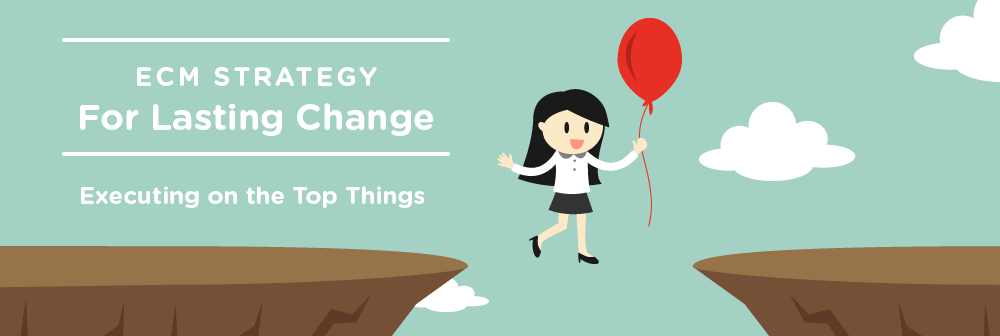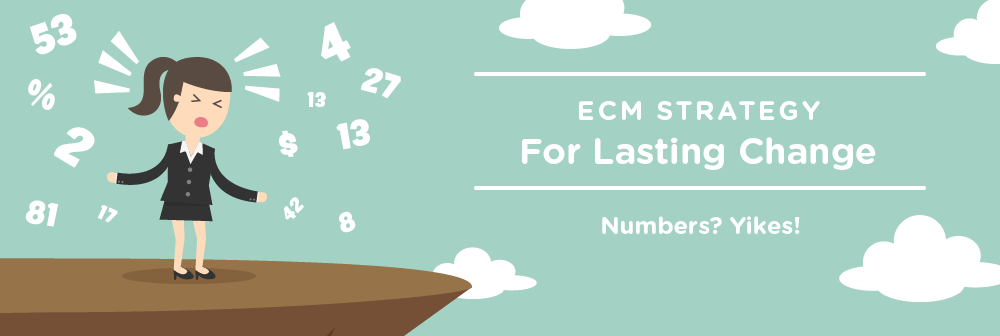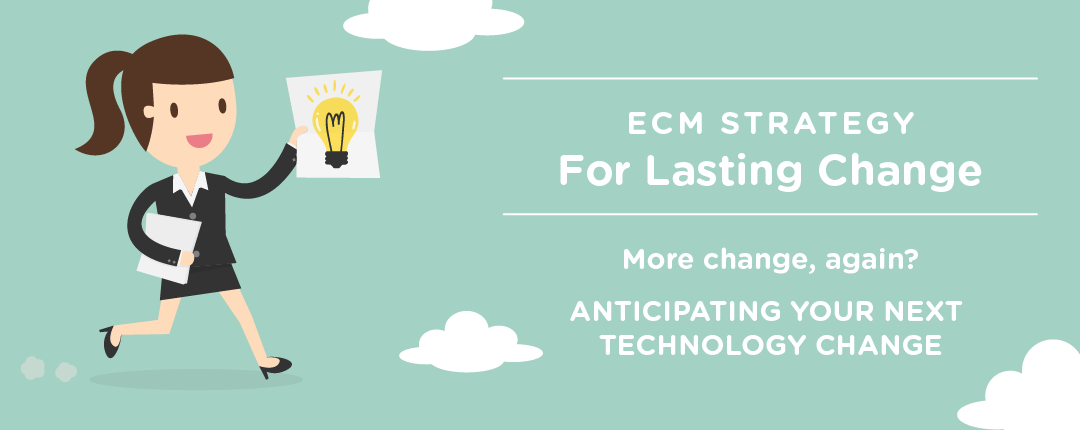Planning for successful technology change. But let’s just GO!
This is the first article of a five-part series on technology strategy techniques that bring about lasting change. In case you missed it, read the introduction.
It may seem obvious, but the first thing to start with when embarking on a significantly large ECM technology change, platform refresh, or software upgrade, is a strategically informed plan. Many organizations don’t do this well or skip it entirely.
Everyone may think that your enterprise project has the green light to begin implementation when procurement finally signs on the dotted line; however, that doesn’t mean you have a map for the inevitable challenges ahead. To be successful, every project has to start with a clear picture of the Why, the Who, and the How.
Why are we doing this project?
At the outset, this seems obvious—especially if you’ve spent a year or more researching the right platform to put in place. When I inquire about success criteria early on during engagements with clients, I usually get reasonably straightforward, yet vague answers such as:
- We have to replace the previous, unsupported system.
- We are rolling out a technology change or refresh to meet growing business needs.
- With minimal disruption to the business, we’re building a more modern, sustainable platform.
All of these are perfectly valid ideas. However, these statements do not provide you with a clear understanding of what you are setting out to accomplish. Like weak user stories in an agile project, these statements are too high level, missing acceptance criteria, and not very motivating!
As a better example, here are some ECM project success criteria that were developed for a medical research company to streamline the paperwork required to start up a new pharmaceutical study. Stronger success criteria should sound more like the following:
- Reduce the person-hours required to generate, distribute, sign, track, and file regulatory documents and forms by 50%.
- Reduce the overall cycle-time to generate, distribute, sign, track, and file regulatory documents/forms required for a pharmaceutical study start-up from two months to 10 days.
- Be compliant with all federal regulations as documented by the Director of Regulatory Compliance.
Getting to the goals and success criteria of the project will guide you time and time again as you set priorities, navigate through roadblocks, and make tough decisions about the project. When questions arise or issues come up, weigh the answers and mitigations against the success criteria. Believe me, when there seems like no perfect answer to a tough problem in the project, you will find comfort in gauging a decision against these criteria to guide you forward.
Strategy Desk Tip:
Struggling with success criteria? Start with a list of what you simply can’t miss doing. In other words, what are one or two of the big things that if the system didn’t do or couldn’t support, would cause it to fail? Write down what is critical and describe how it will work to empower your business. AND, think ahead to how the success of that feature can be measured.
Who is working on it?
Once you have the core project goals figured out, defining the right roles and skillsets to execute the project will be the next big challenge. If an ECM solution has been in place there may be existing staff available to transition into roles on the new solution. However, there are two precautions to taking this approach. First, it may be that the team already in place won’t be relieved of their current responsibilities on an existing platform unless some tough decisions are made to stop working on or supporting the platform. Many times, this isn’t an option, so backfilling roles or picking up new resources to work on the new platform may be necessary. Stretching people too thin between the old and new solutions may not set a team up for success.
Second, it is critical to review the new roles needed on a new solution. Are the foundational skills and technology stack the same, or are new resources needed that have different skillsets? Do some people need training in new areas? Starting with role definitions for the new platform in a neutral way—meaning starting with the roles needed, not the current resources available—should be started as soon as it is known the direction that the platform is going. It may be that some of the resources available currently will have the right skills, passion, and bandwidth, but know your resourcing roles and responsibilities before filling the needs with the current ECM team members.
Strategy Desk Tip:
Remember, team creation is more an art than a game of Tetris. Clearly define the roles needed to staff the project and fight for the correct people to fill those roles. You may have to have a discussion about hiring or getting contractor help where you have critical gaps.
How will we get there?
Hidden inside this is actually another question. In other words, executives more commonly want to know, “When will it be done?” To avoid the pitfall of talking only about dates projected on an overwhelming gantt chart, ensure you have all the project data points (clearly stated requirements, dependencies, and integration points) and can accurately answer how the team will build what is needed. I’ll share much more on how to get there in my next post.
Strategy Desk Tip:
Following a solid methodology is a skill that newly formed teams need to learn and adopt. Above all, set priorities, communicate regularly about expectations, and encourage cross-team collaboration.
Discovery and Assessment
The Zia team has been working to drive strategic ECM projects for over a decade. The more we learn about ECM, the more we realize that our most successful projects have started with a solid understanding of the project, the team, and the plan to get going. We nearly always start with our discovery and assessment, even on the smallest of projects. If you believe your project is small enough to accomplish in eight to 12 weeks’ time, you should still take about a week on the front end to strategize and plan the why, who, and how. If you are replacing a system that has been in place for five years or more with hundreds or thousands of end-users, we highly recommend spending at least three to four weeks to get the right plan in place.
Strategy Desk Tip:
To kick everything off in the right direction, you may need the help of a talented facilitator. Find someone you trust with the right skillset, inside or outside your organization who can lead you through discovery sessions.
Key Takeaways:
Discover your success criteria: It is critical that you know what success looks like. And, guess what? I bet success isn’t illustrated by the system you have in place today, so
don’t rely solely upon that as your blueprint.
Invest in the right team: Team members have to have the talent, desire, and time to participate and contribute to the project.
You need more than a calendar-driven chart: The plan is more than a Gantt chart. The plan includes milestones, quick wins, building blocks, user engagement, and a clear methodology for delivery. I’ll be discussing more on this in my next post in the series…





